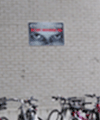April
Watching eyes reduce bike theft

Bicycle theft can be significantly reduced simply by placing pictures of staring eyes above bike racks, researchers at Newcastle University have found.
In a two year experiment on the university campus, the academics managed to reduce thefts from the racks with the eye pictures, combined with a short anti-theft message, by 62%. And there was also a noticeable difference in places without the signs, where bike theft went up by 63%, suggesting that the crime had been displaced to other locations, rather than eliminated.
The findings have already led to changes on the Newcastle University campus and the team are working with police across the country to advise them on how they may be able to use the research.
Professor Melissa Bateson and Professor Daniel Nettle of the Centre for Behaviour and Evolution, and Ken Nott of the University’s security team, describe their findings in a paper published in the journal PLoS ONE.
For the first year the team monitored the level of bike theft at all racks across campus for a control figure. Then they placed the signs in three locations, leaving the rest of the racks without signs. They then monitored the whole lot again for a year to see what the impact on the level of crime would be.
In a previous study in 2006 the same scientists looked at the impact of images of eyes on contributions to an honesty box in a tea room. They found that people put nearly three times more money in the box when there were eyes compared with flowers. Then in 2010 they found people were more likely to clean away their tray after a meal when there were eyes watching them.
Lead author of the paper, Professor Daniel Nettle, said: “We don’t know exactly what is happening here but this just adds to the growing evidence that images of eyes can have a big impact on behaviour.
“We think that the presence of eye images can encourage co-operative behaviour. One strong possibility is that the images of eyes work by making people feel watched. We care what other people think about us, and as a result we behave better when we feel we are being observed.
“The next step would be to increase the scope of the experiment across a citywide area to see if the effect is maintained, but the pattern definitely looks like it is worth exploring further.”
Ken Nott, Deputy Team Leader for security in the Estates Security Service at Newcastle University said: “Anything we can do to reduce the level of theft on the campus is very welcome. I had followed previous work done by this team and thought it might be able to make a difference to levels of crime, so I decided to suggest this experiment. The results were clear and we have now put these pictures up across all the bike racks on the campus.”
As a part of our strategy in combating the high levels of cycle theft within the University boundaries I implemented the anti cycle theft eye signage in partnership with Medical Sciences as part of a real world experiment.
The scheme has proved so successful that the British Transport Police are trialling it, with train Company C2C, on a route between Fenchurch Street Station in London and Southend in Essex.
Barry Sharp from the London North Area Crime Team of the BTP said: “Research shows that this sign has had some promising results at Newcastle University, and we are always looking at new ways to tackle cycle theft at rail stations.
“As well signs at stations and increased patrols at hot spot locations, we aim to crack down on cycle thieves across Essex.”
published on: 24 April 2013
